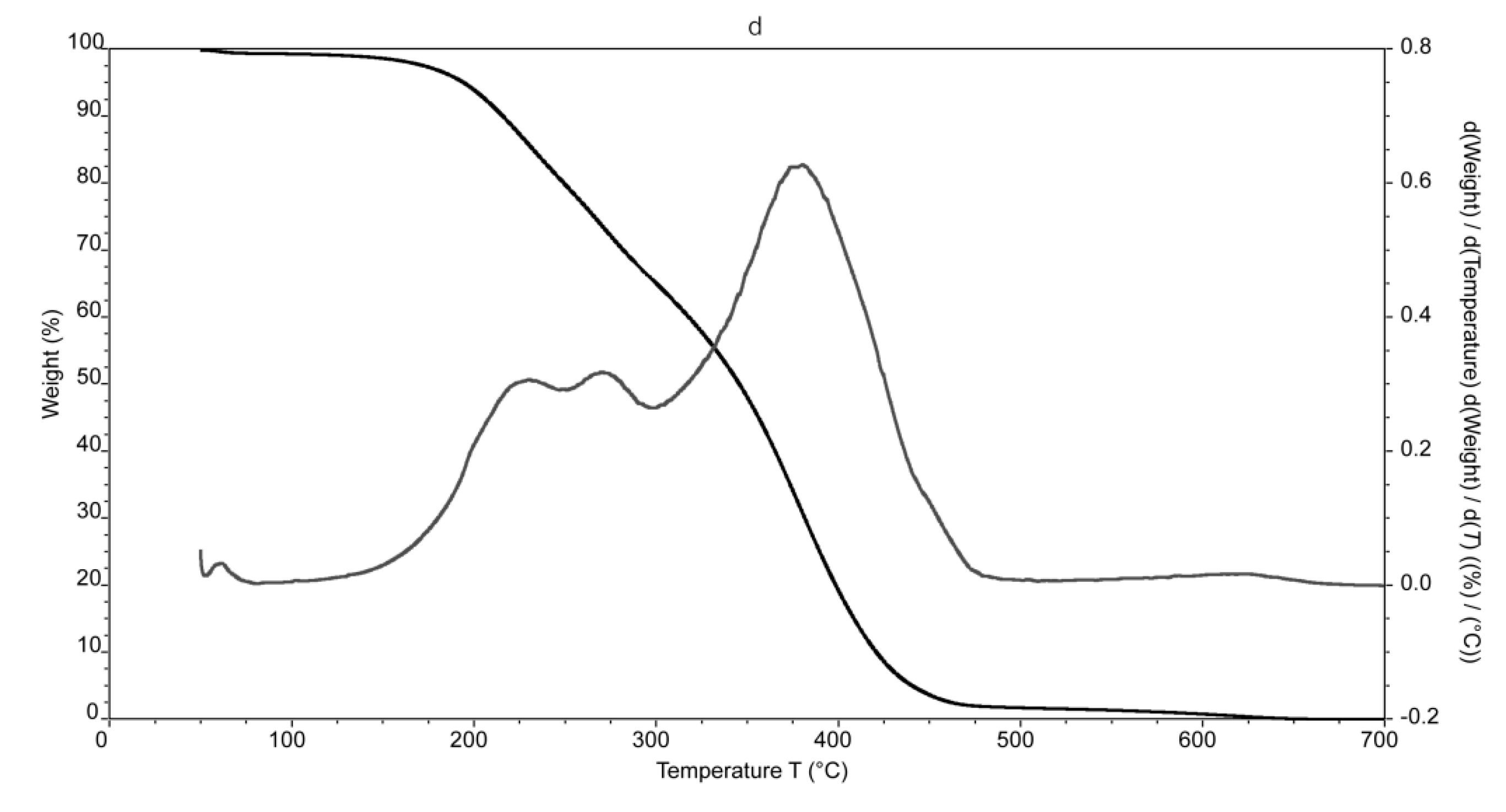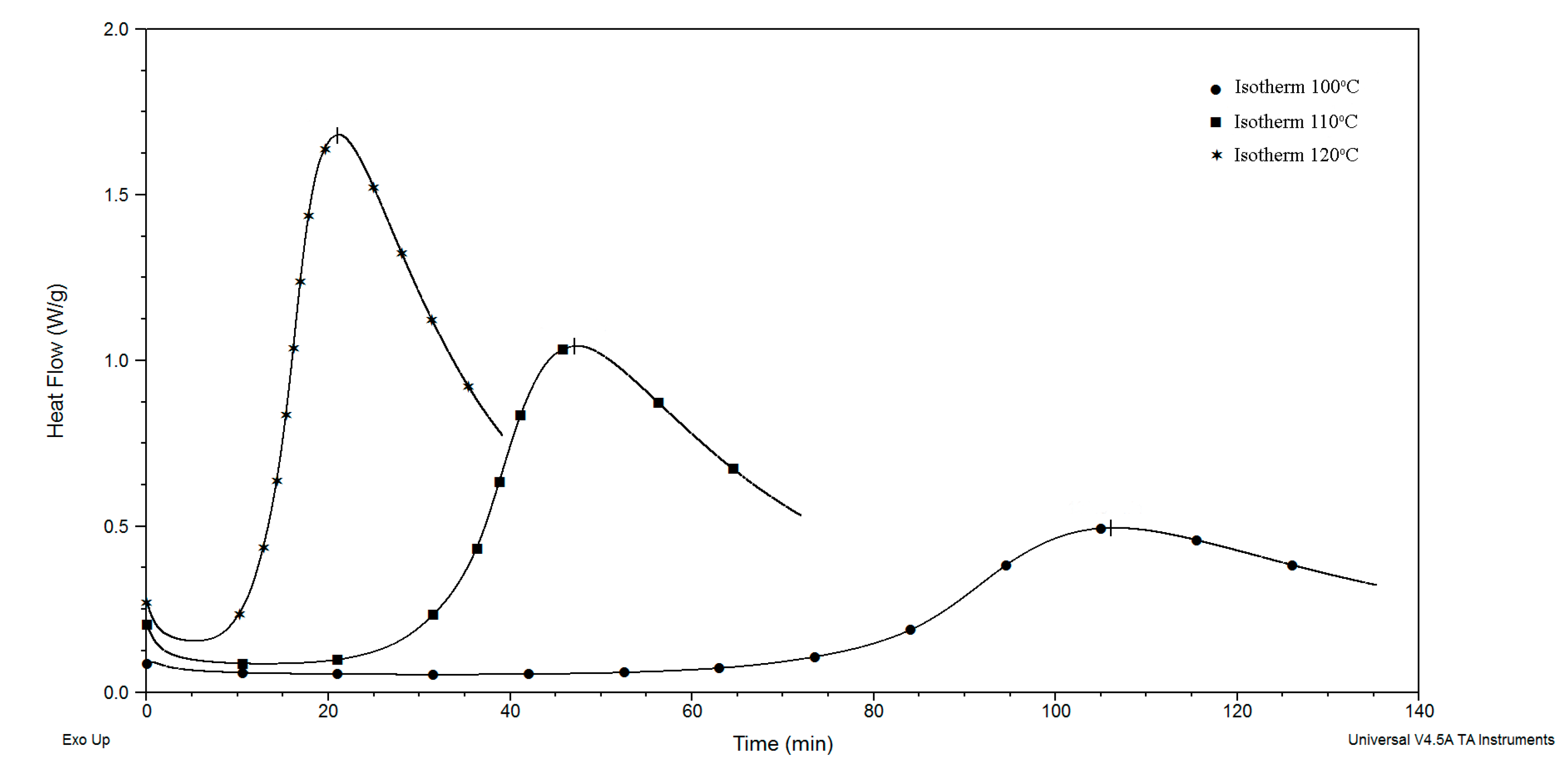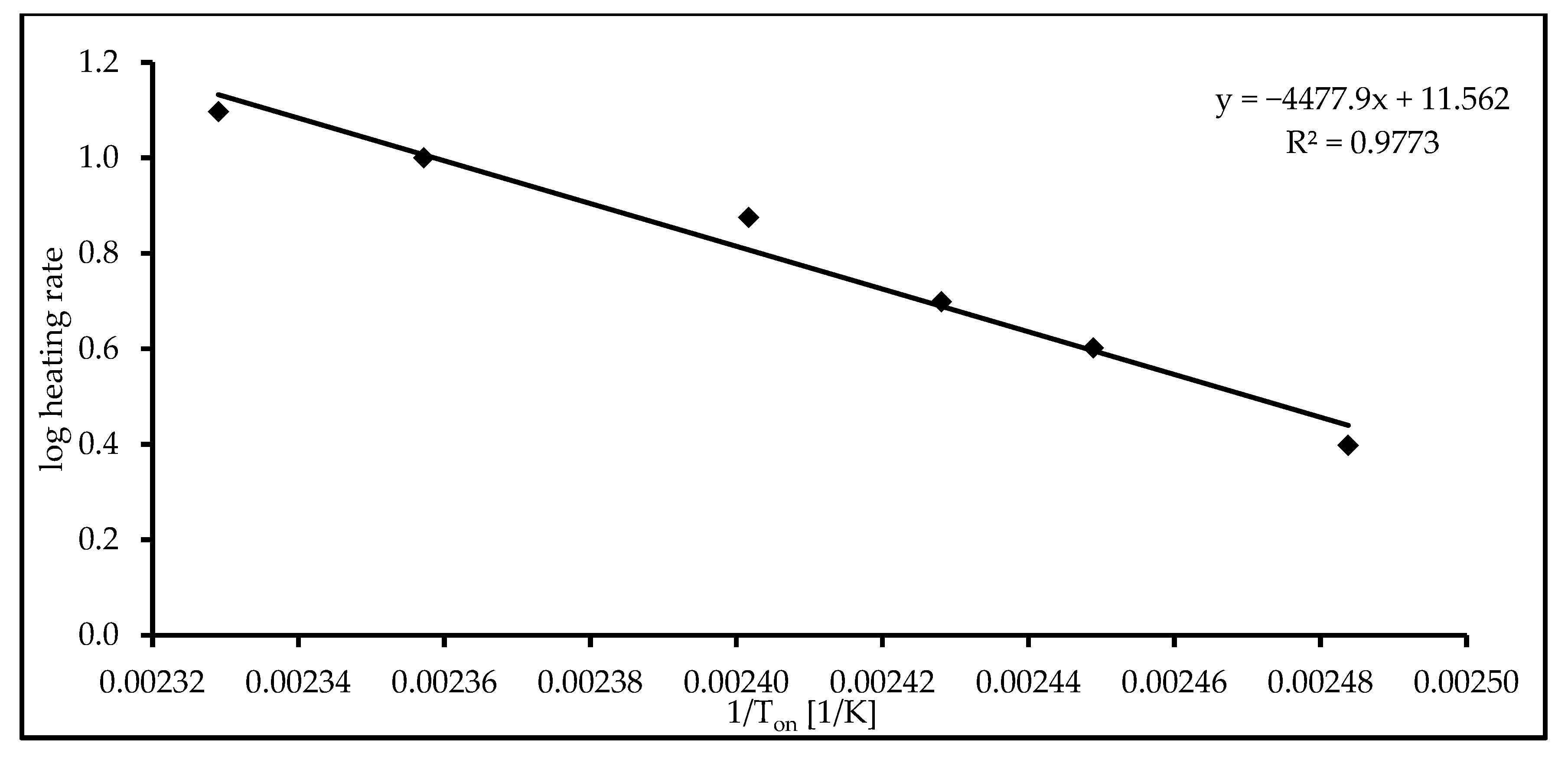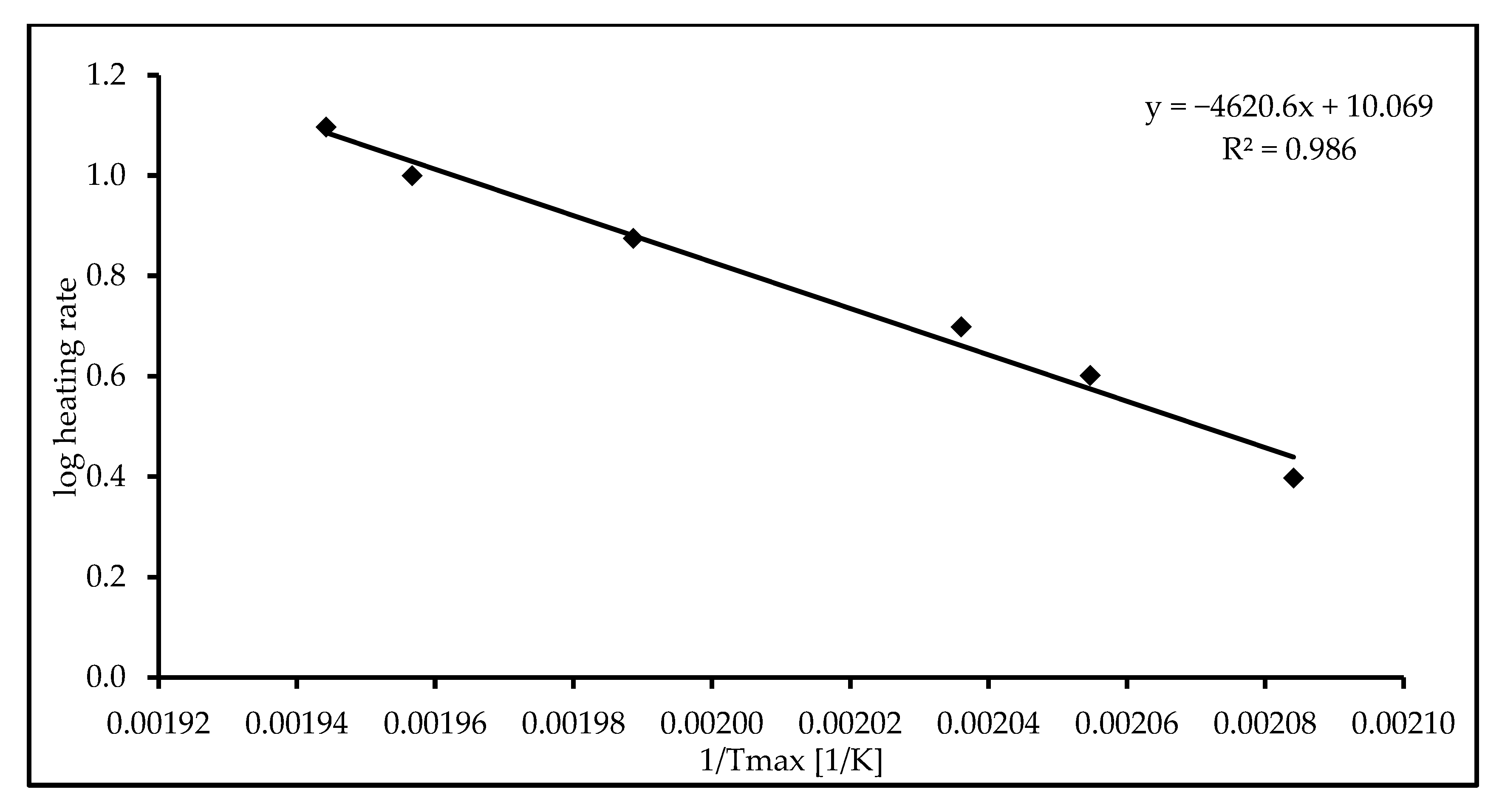Application of Thermal Methods to Analyze the Properties of Coffee Silverskin and Oil Extracted from the Studied Roasting By-Product
Abstract
Featured Application
Abstract
1. Introduction
2. Materials and Methods
2.1. Study of Coffee Silverskin
2.1.1. DSC Study of Coffee Silverskin
2.1.2. MDSC Study of Coffee Silverskin
2.1.3. TG/DTG Study of Coffee Silverskin
2.2. Study of Fat Extracted from Coffee Silverskin
2.2.1. Extraction of Fat from Coffee Silverskin
2.2.2. Pressure Differential Scanning Calorimetry (PDSC) Study of Coffee Silverskin Oil
2.2.3. TG/DTG Study of Coffee Silverskin Oil
2.2.4. GC Measurements of Coffee Silverskin Oil
2.3. Statistical Analysis
3. Results and Discussion
3.1. Study of Coffee Silverskin
3.1.1. DSC Study of Coffee Silverskin
3.1.2. TG/DTG Analysis of Coffee Silverskin
3.1.3. Glass Transition Temperature of Coffee Silverskin Sample
3.2. Study of Coffee Silverskin Oil
3.2.1. TG/DTG Analysis of Coffee Silverskin Oil
3.2.2. PDSC Study of Coffee Silverskin Oil
3.2.3. GC Study of Coffee Silverskin Oil
4. Conclusions
Author Contributions
Funding
Conflicts of Interest
References
- Mussatto, S.I.; Ballesteros, L.F.; Martins, S.; Teixeira, J.A. Extraction of antioxidant phenolic compounds from spent coffee grounds. Sep. Purif. Technol. 2011, 83, 173–179. [Google Scholar] [CrossRef]
- Belitz, H.D.; Grosch, W.; Schieberle, P. Food Chemistry, 4th ed.; Springer: Berlin/Heidelberg, Germany, 2009; pp. 938–950. [Google Scholar]
- Niglio, S.; Procentese, A.; Russo, M.E.; Sannia, G.; Marzocchella, A. Investigation of enzymatic hydrolysis of coffee silverskin aimed at the production of butanol and succinic acid by fermentative processes. BioEnerg. Res. 2019, 12, 312–324. [Google Scholar] [CrossRef]
- Ballesteros, L.F.; Teixeira, J.A.; Mussatto, S.I. Chemical, functional, and structural properties of spent coffee grounds and coffee silverskin. Food Bioprocess. Technol. 2014, 7, 3493–3503. [Google Scholar] [CrossRef]
- International Coffee Organization. Total Production by All Exporting Countries. 2020. Available online: http://www.ico.org/prices/po-production.pdf/ (accessed on 1 December 2020).
- Stahel, W.R. The Circular Economy. Nature 2016, 531, 435–438. Available online: https://www.nature.com/news/the-circular-economy-1.19594/ (accessed on 1 February 2018). [CrossRef] [PubMed]
- Jimenez-Zamora, A.; Pastoriza, S.; Rufian-Henares, J.A. Revalorization of coffee by-products. Prebiotic, antimicrobial ant antioxidant properties. LWT-Food Sci. Technol. 2015, 61, 12–18. [Google Scholar] [CrossRef]
- Narita, Y.; Inouye, K. High antioxidant activity of coffee silverskin extracts obtained by the treatment of coffee silverskin with subcritical water. Food Chem. 2012, 135, 943–949. [Google Scholar] [CrossRef]
- Esquivel, P.; Jimenez, V.M. Functional properties of coffee and coffee by-products. Food Res. Int. 2012, 46, 488–495. [Google Scholar] [CrossRef]
- Bresciani, L.; Calani, L.; Bruni, R.; Brighenti, F.; Del Rio, D. Phenolic composition, coffeine content and antioxidant capacity of coffee silverskin. Food Res. Int. 2014, 61, 196–201. [Google Scholar] [CrossRef]
- Ates, G.; Elmaci, Y. Coffee silverskin as fat replacer in cake formulations and its effect on physical, chemical and sensory attributes of cake. LWT-Food Sci. Technol. 2018, 90, 519–525. [Google Scholar] [CrossRef]
- Murthy, P.S.; Naidu, M.M. Sustainable management of coffee industry by-products and value addition—A review. Resour. Conserv. Recycl. 2012, 66, 45–58. [Google Scholar]
- Jannisen, B.; Huynh, T. Chemical composition and value-adding application of coffee industry by-products—A review. Resour. Conserv. Recycl. 2018, 128, 110–117. [Google Scholar] [CrossRef]
- Ostrowska-Ligęza, E.; Górska, A.; Wirkowska-Wojdyła, M.; Koczoń, P. An assessment of various powdered baby formulas by conventional methods (DSC) or FT-IR spectroscopy. J. Therm. Anal. Calorim. 2012, 110, 465–471. [Google Scholar] [CrossRef]
- Ostrowska-Ligęza, E.; Jakubczyk, E.; Górska, A.; Wirkowska-Wojdyła, M.; Bryś, J. The use of moisture sorption isotherms and glass transition temperature to assess the stability of powdered baby formulas. J. Therm. Anal. Calorim. 2014, 118, 911–918. [Google Scholar] [CrossRef]
- Bryś, J.; Wirkowska-Wojdyła, M.; Górska, A.; Ostrowska-Ligęza, E.; Bryś, A. Application of the calorimetric and spectroscopic methods in analytical evaluation of the human milk fat substitutes. J. Therm. Anal. Calorim. 2014, 118, 841–848. [Google Scholar] [CrossRef]
- Ostrowska-Ligęza, E.; Górska, A.; Wirkowska-Wojdyła, M.; Bryś, J.; Dolatowska-Żebrowska, K.; Shamilowa, M.; Ratusz, K. Thermogravimetric characterization of dark and milk chocolates at different processing stages. J. Therm. Anal. Calorim. 2018, 134, 623–631. [Google Scholar] [CrossRef]
- Kaletunç, G. Calorimetry in Food Processing: Analysis and Design of Food Systems, 1st ed.; Wiley-Blackwell: Hoboken, NJ, USA, 2009. [Google Scholar]
- Górska, A.; Szulc, K.; Ostrowska-Ligęza, E.; Bryś, J.; Wirkowska-Wojdyła, J. Effect of composition and drying method on glass transition temperature, water sorption characteristics and surface morphology of newly-designed β-lactoglobulin/retinyl palmitate/disaccharides systems. J. Therm. Anal. Calorim. 2017, 130, 177–185. [Google Scholar] [CrossRef]
- Hinz, H.J.; Schwarz, F.P. Measurements and analysis of results obtained on biological substances with differential scanning calorimetry. Pure Appl. Chem. 2001, 73, 745–759. [Google Scholar] [CrossRef]
- Wang, Q.; Tolkach, A.; Kulozik, U. Quantative assessment of thermal denaturation of bovine α-lactoalbumin via low intensity ultrasound, HPLC, and DSC. J. Agric. Food Chem. 2006, 54, 6501–6506. [Google Scholar] [CrossRef]
- Lee, J.; Kaletunç, G. Calorimetric determination of inactivation parameters of microorganisms. J. Appl. Microbiol. 2002, 93, 178–189. [Google Scholar] [CrossRef]
- Lee, J.; Kaletunç, G. Evaluation by differential scanning calorimetry of the effect of acid, ethanol, and NaCl on Escherichia coli. J. Food Prot. 2005, 68, 487–493. [Google Scholar] [CrossRef]
- Loisel, C.; Keller, G.; Lecq, G.; Bourgaux, C.; Ollivon, M. Phase transitions and polymorphism of cocoa butter. J. Am. Oil Chem. Soc. 1998, 75, 425–439. [Google Scholar] [CrossRef]
- Lopez, C.; Lavigne, F.; Lesieur, P.; Keller, G.; Ollivon, M. Thermal and structural behavior of anhydrous milk fat: 2. Crystalline forms obtained by slow cooling. J. Dairy Sci. 2001, 84, 2402–2412. [Google Scholar] [CrossRef]
- Lopez, C.; Briard-Bion, V.; Camier, B.; Gassi, J.Y. Milk fat thermal properties and solid fat content in Emmental cheese: A differential scanning calorimetry. J. Dairy Sci. 2006, 89, 2894–2910. [Google Scholar] [CrossRef]
- Brynda-Kopytowska, A.; Górska, A.; Bryś, J.; Domian, E.; Wirkowska-Wojdyła, M.; Ostrowska-Ligęza, E. Application of DSC and GC methods for characterization of newly designed spray-dried pea protein-fat preparations formulated with different types of a carbohydrate components. J. Therm. Anal. Calorim. 2018, 134, 609–621. [Google Scholar] [CrossRef]
- Wirkowska-Wojdyła, M.; Bryś, J.; Ostrowska-Ligęza, E.; Górska, A.; Chmiel, M.; Słowiński, M.; Piekarska, J. Quality and oxidative stability of model meat batters as affected by interesterified fat. Int. J. Food Prop. 2019, 22, 607–617. [Google Scholar] [CrossRef]
- Ciemniewska-Żytkiewicz, H.; Bryś, J.; Sujka, K.; Koczoń, P. Assessment of the hazelnuts roasting process by pressure differential scanning calorimetry and MID FT-IR spectroscopy. Food Anal. Methods 2015, 8, 2465–2473. [Google Scholar] [CrossRef]
- Tan, C.P.; Che Man, Y.B. Recent developments in differential scanning calorimetry for assessing oxidative deterioration of vegetable oils. Trends Food Sci. Technol. 2002, 13, 312–318. [Google Scholar] [CrossRef]
- Velasco, J.; Andersen, M.L.; Skibsted, L.H. Evaluation of oxidative stability of vegetable oils by monitoring the tendency to radical formation. A comparison of electron spin resonance spectroscopy with the Rancimat method and differential scanning calorimetry. Food Chem. 2004, 85, 624–632. [Google Scholar] [CrossRef]
- Polish Norm: PN-ISO 3534-2:1994: Statistical Quality Control. Terminology and Symbols; Polish Committee for Standardization: Warsaw, Poland, 1994.
- Reder, M.; Koczoń, P.; Wirkowska, M.; Sujka, K.; Ciemniewska-Żytkiewicz, H. The application of FT-MIR spectroscopy for the evaluation of energy value, fat content, and fatty acid composition in selected organic oat products. Food Anal. Methods 2014, 7, 547–554. [Google Scholar] [CrossRef]
- Wirkowska-Wojdyła, M.; Bryś, J.; Górska, A.; Ostrowska-Ligęza, E. Effect of enzymatic interesterification on physicochemical and thermal properties of fat used in cookies. LWT-Food Sci. Technol. 2016, 74, 99–105. [Google Scholar] [CrossRef]
- Polish Norm: PN-EN ISO: 5509:2001: Oil and Vegetable and Animal Fats. Preparation of Methyl Ester of Fatty Acids; Polish Committee for Standardization: Warsaw, Poland, 2001.
- Bryś, A.; Bryś, J.; Ostrowska-Ligęza, E.; Kaleta, A.; Górnicki, K.; Głowacki, S.; Koczoń, P. Wood biomass characterization by DSC or FT-IR spectroscopy. J. Therm. Anal. Calorim. 2016, 126, 27–35. [Google Scholar] [CrossRef]
- Yang, H.; Yan, R.; Chen, H.; Lee, D.H.; Zheng, C. Characteristics of hemicellulose, cellulose and lignin pyrolysis. Fuel 2007, 86, 1781–1788. [Google Scholar] [CrossRef]
- Tarrio-Saavedra, J.; Naya, S.; Francisco-Fernandez, M.; Lopez-Beceiro, J.; Artiaga, R. Functional nonparametric of wood species from thermal data. J. Therm. Anal. Calorim. 2011, 104, 87–100. [Google Scholar] [CrossRef]
- Bhandari, B.R.; Howes, T. Implication of glass transition for the drying and stability of dried foods. J. Food Eng. 1999, 40, 71–79. [Google Scholar] [CrossRef]
- Gouveia de Souza, A.; Oliveira Santos, J.C.; Conceição, M.M.; Dantas Silva, M.C.; Prasad, S. A thermoanalytic and kinetic study of sunflower oil. Braz. J. Chem. Eng. 2004, 21, 265–273. [Google Scholar] [CrossRef]
- Kowalski, B.; Gruczyńska, E.; Maciaszek, K. Kinetics of rapeseed oil oxidation by pressure differential scanning calorimetry measurements. Eur. J. Lipid Sci. Technol. 2000, 102, 337–341. [Google Scholar] [CrossRef]
- Ciemniewska-Żytkiewicz, H.; Ratusz, K.; Bryś, J.; Reder, M.; Koczoń, P. Determination of the oxidative stability of hazelnut oils by PDSC and Rancimat methods. J. Therm. Anal. Calorim. 2014, 118, 875–881. [Google Scholar] [CrossRef]
- Adhvaryu, A.; Erhan, S.Z.; Liu, Z.S.; Perez, J.M. Oxidation kinetic studies of oils derived from unmodified and genetically modified vegetables using pressurized differential scanning calorimetry and nuclear magnetic resonance spectroscopy. Thermochim. Acta 2000, 364, 87–97. [Google Scholar] [CrossRef]







| Type of Fat | Heating Rate (β) (K/min) | Ton (°C) | Tmax (°C) |
|---|---|---|---|
| Fat extracted from coffee silverskin | 2.5 | 129.46 ± 2.8 | 206.68 ± 2.6 |
| 4.0 | 135.20 ± 3.2 | 213.55 ± 3.9 | |
| 5.0 | 138.70 ± 3.9 | 218.01 ± 4.4 | |
| 7.5 | 143.23 ± 2.4 | 229.72 ± 6.7 | |
| 10.0 | 151.08 ± 1.9 | 237.94 ± 3.5 | |
| 12.5 | 156.21 ± 3.1 | 241.21 ± 3.1 |
| Parameter | Value Calculated for Ton | Value Calculated for Tmax |
|---|---|---|
| a | −4477.9 | −4620.6 |
| b | 11.6 | 10.1 |
| R2 | 0.98 | 0.90 |
| Ea (kJ/mol) | 81.52 | 84.12 |
| Z | 7.68 × 109 | 2.39 × 108 |
| Group of Fatty Acids | Fatty Acid | Content of Individual Fatty Acid (%) * | Ʃ Content of the Group (%) * |
|---|---|---|---|
| SFA | C12:0 | 0.08 ± 0.01 | 46.37 ± 0.05 |
| C14:0 | 1.86 ± 0.06 | ||
| C15:0 | 0.19 ± 0.01 | ||
| C16:0 | 28.26 ± 0.09 | ||
| C18:0 | 8.04 ± 0.05 | ||
| C20:0 | 7.41 ± 0.09 | ||
| C21:0 | 0.33 ± 0.04 | ||
| C24:0 | 0.20 ± 0.04 | ||
| PUFA | C18:2n-6c | 32.47 ± 0.09 | 42.58 ± 0.25 |
| C18:3n-6 | 1.62 ± 0.07 | ||
| C18:3n-3 | 1.44 ± 0.04 | ||
| C20:2 | 0.10 ± 0.02 | ||
| C20:3 n-3 | 5.50± 0.06 | ||
| C22:2 | 0.23 ± 0.04 | ||
| C20:5 n-3 | 1.22 ± 0.02 | ||
| MUFA | C16:1 | 0.10 ± 0.01 | 7.81 ± 0.05 |
| C18:1n-9c | 7.08 ± 0.04 | ||
| C20:1 c | 0.51 ± 0.02 | ||
| C24:1 | 0.12 ± 0.02 | ||
| Ʃ identified | 96.76 ± 0.20 | ||
| Ʃ other minor unidentified | 3.24 ± 0.20 | ||
Publisher’s Note: MDPI stays neutral with regard to jurisdictional claims in published maps and institutional affiliations. |
© 2020 by the authors. Licensee MDPI, Basel, Switzerland. This article is an open access article distributed under the terms and conditions of the Creative Commons Attribution (CC BY) license (http://creativecommons.org/licenses/by/4.0/).
Share and Cite
Górska, A.; Brzezińska, R.; Wirkowska-Wojdyła, M.; Bryś, J.; Domian, E.; Ostrowska-Ligęza, E. Application of Thermal Methods to Analyze the Properties of Coffee Silverskin and Oil Extracted from the Studied Roasting By-Product. Appl. Sci. 2020, 10, 8790. https://doi.org/10.3390/app10248790
Górska A, Brzezińska R, Wirkowska-Wojdyła M, Bryś J, Domian E, Ostrowska-Ligęza E. Application of Thermal Methods to Analyze the Properties of Coffee Silverskin and Oil Extracted from the Studied Roasting By-Product. Applied Sciences. 2020; 10(24):8790. https://doi.org/10.3390/app10248790
Chicago/Turabian StyleGórska, Agata, Rita Brzezińska, Magdalena Wirkowska-Wojdyła, Joanna Bryś, Ewa Domian, and Ewa Ostrowska-Ligęza. 2020. "Application of Thermal Methods to Analyze the Properties of Coffee Silverskin and Oil Extracted from the Studied Roasting By-Product" Applied Sciences 10, no. 24: 8790. https://doi.org/10.3390/app10248790
APA StyleGórska, A., Brzezińska, R., Wirkowska-Wojdyła, M., Bryś, J., Domian, E., & Ostrowska-Ligęza, E. (2020). Application of Thermal Methods to Analyze the Properties of Coffee Silverskin and Oil Extracted from the Studied Roasting By-Product. Applied Sciences, 10(24), 8790. https://doi.org/10.3390/app10248790










